Looking to create a mobile app without diving deep into coding? React Native no-code app builders are here to transform your idea into reality, effortlessly. Whether you're a developer, business owner, or a curious mind, these tools offer a straightforward path to develop both iOS and Android apps. Here's a quick rundown:
- React Native: A framework for building native apps using JavaScript.
- No-Code Development: Build apps without writing code using drag-and-drop interfaces.
- Why React Native?: Offers cross-platform support, faster development, and reduces costs.
- Top Tools: Draftbit, Glide, Bubble, and more, each with unique features from easy drag-and-drop interfaces to complex functionalities without the need for coding.
- Choosing the Right Tool: Consider ease of use, customization, features, and cost among other factors.
In simple terms, no-code platforms are changing the game, making app development accessible to everyone. With React Native, you get the added advantage of cross-platform support, ensuring your app reaches a wider audience. Ready to start? Pick a builder that fits your project's needs and jump into creating your app today.
Why React Native for No Code App Development?
React Native is a favorite way to make apps for both iPhones and Android phones without having to write different codes for each. It works well with tools that let you build apps without knowing how to code, making it super handy for creating apps quickly and without much hassle.
Here's why React Native is great for this kind of app making:
Cross-Platform Support
- With React Native, you can make an app once, and it will run on both iOS and Android. This means you don't have to make a separate app for each type of phone.
- Tools like Draftbit and AppMaster use React Native, so you can drag and drop pieces to make your app work on all phones.
Faster Development and Prototyping
- Since you can use the same code for both types of phones, making an app is much quicker.
- These no-code tools make it even faster because you don't have to write any code at all. You can put together an app just by picking and placing parts.
Improved Performance
- React Native turns your app into something that works almost like it was made specifically for that type of phone, which means it runs smoothly.
- Even when using no-code tools, your app can still run well because React Native is built for performance.
Code Reuse and Maintenance
- You can use the same bits of code for different versions of your app, which makes it easier to keep everything up-to-date.
- With no-code tools, you don't need a coder to update your app. You can do it yourself from a simple control panel.
Lower Development Costs
- Using the same code for both iOS and Android apps saves money compared to making two separate apps.
- Also, because you don't need coders to use these no-code tools, making an app is cheaper.
Ease of Learning and Usage
- React Native uses JavaScript, a common language for making websites, so it's not too hard to get the hang of.
- No-code tools make it even easier because they take care of the coding for you. Anyone can start making an app right away.
Vibrant Community Support
- Since React Native is open for anyone to use, there's a big group of people out there who can help if you get stuck.
- This support also applies to no-code tools built with React Native, so you're never alone.
In short, React Native makes it easy to build apps for both iPhones and Android phones without needing to know a lot about coding. When you pair it with no-code tools, it's even easier and cheaper to make good apps quickly.
Top React Native No Code App Builders
Let's look at some of the best tools out there for building apps without needing to code, focusing on React Native. We'll cover what makes each tool stand out, plus the good and not-so-good parts.
Draftbit

Draftbit is a tool that lets you build apps by just dragging and dropping parts. You don't need to code. Here's what's cool about it:
- Easy to use, drag and drop to make your app look how you want
- Lots of pre-made parts and designs you can use
- Can make apps for both iPhone and Android
- Connects with other web services easily
- Lets you put your app in app stores
Pros: Great for making apps quickly with a visual approach. Lots of parts to use. Good for teamwork.
Cons: Not as flexible as coding by hand. Might not do everything you want. Can be tricky to learn at first.
Zapier Interfaces
Zapier Interfaces helps you connect different apps and automate tasks. It's not just about building apps but making them work smarter. Highlights include:
- Links up thousands of apps
- Lets you create custom workflows
- Focuses on making apps work together better
- Simple to use
Pros: Good for automating tasks between apps. Lots of app connections. Has a free version.
Cons: More about connecting apps than building new ones. Can be hard for beginners.
Glide
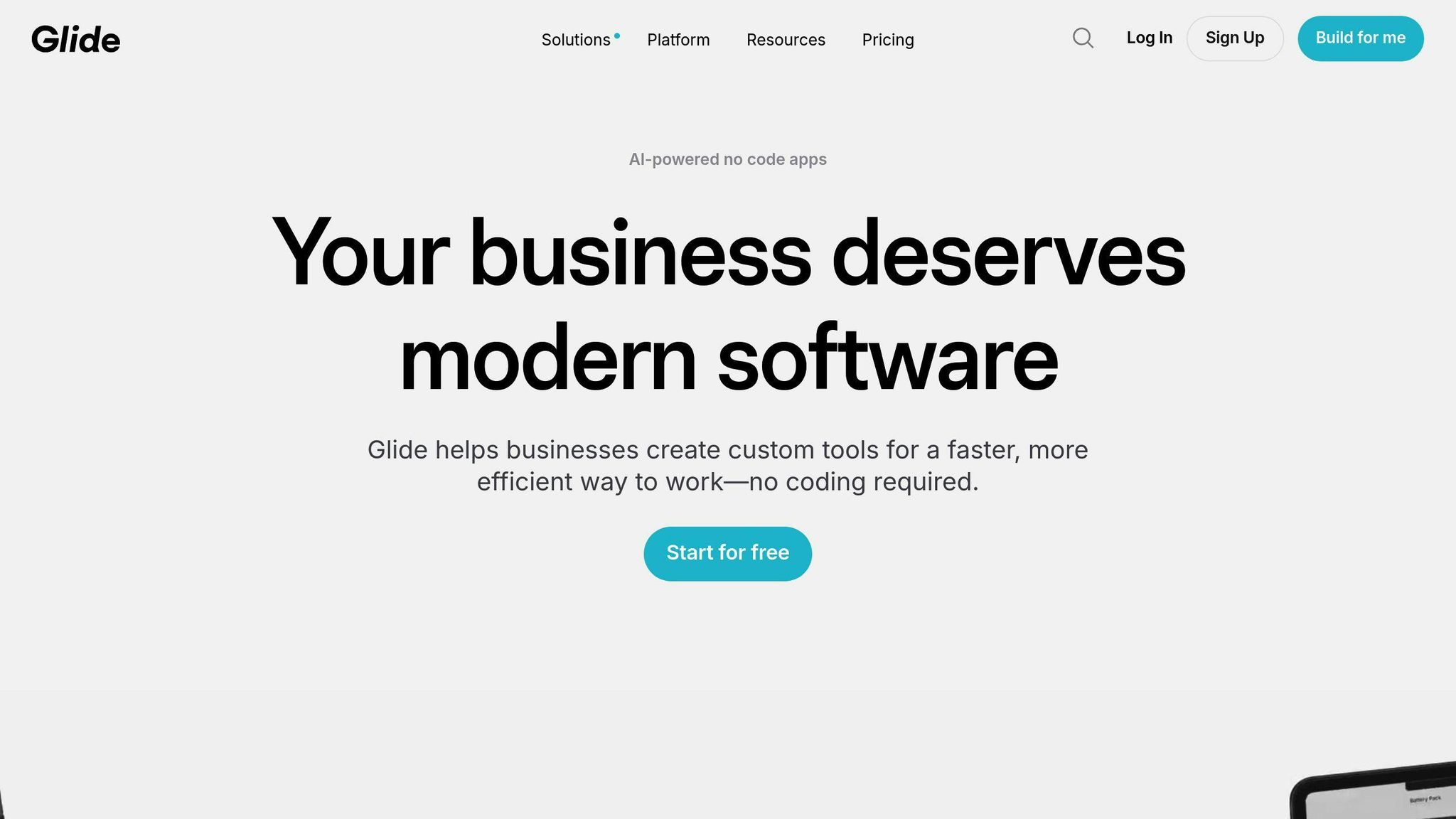
Glide is a straightforward tool for making simple mobile apps fast. What's great about it:
- Easy drag and drop builder
- Pretty templates to start with
- Lets you try your app on your phone
- Basic tools for managing data and logic
Pros: Super easy for beginners. Quick to make good-looking simple apps.
Cons: Not great for complex apps. Limited in what you can change.
Softr
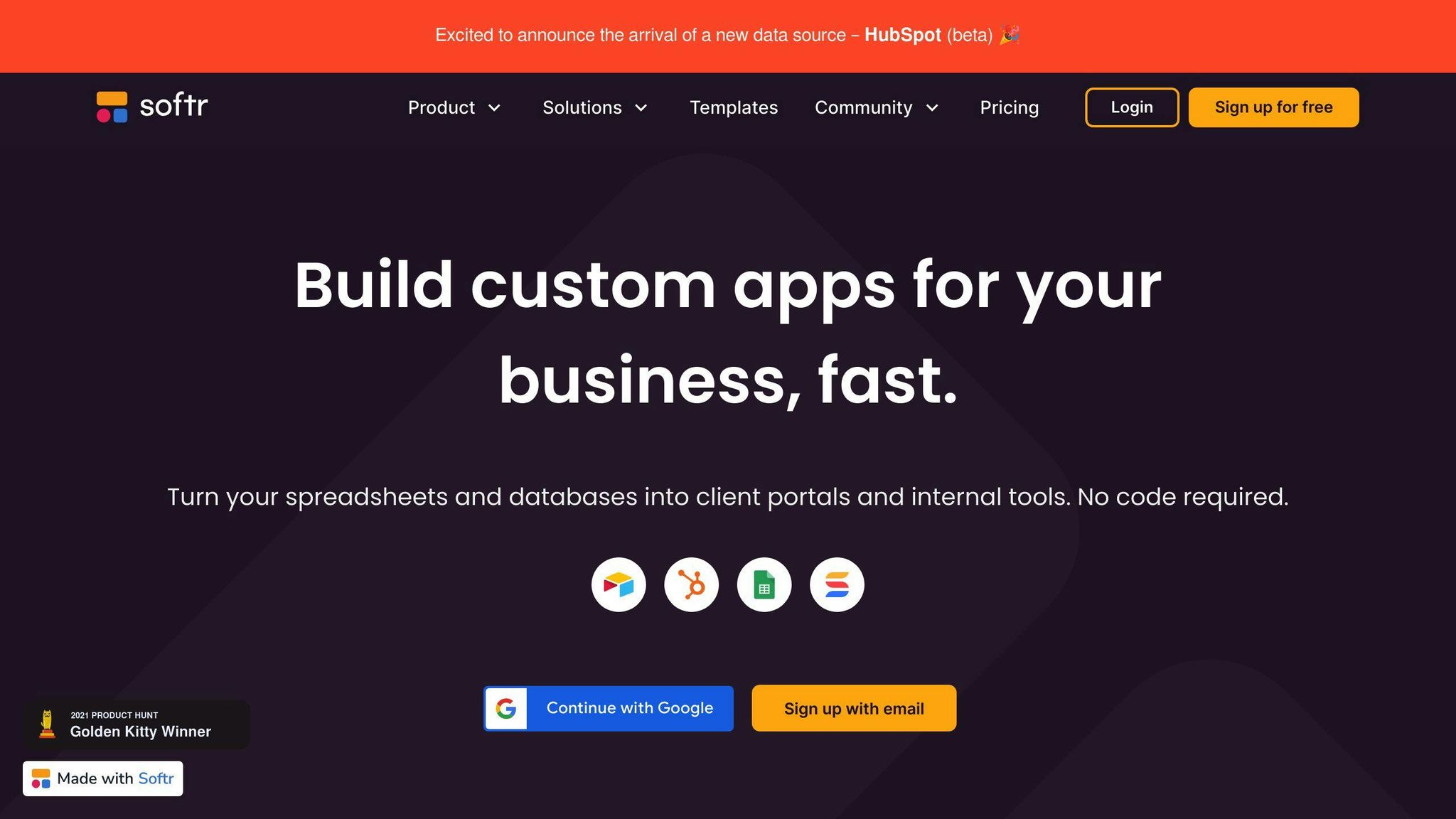
Softr is all about making it super easy for anyone to build web and mobile apps. Key points:
- Drag and drop building
- Lots of useful templates
- Can manage users and take payments
- Host your apps online
Pros: Perfect for beginners. Straightforward to use.
Cons: Not much room for customization. Pretty basic.
Bubble
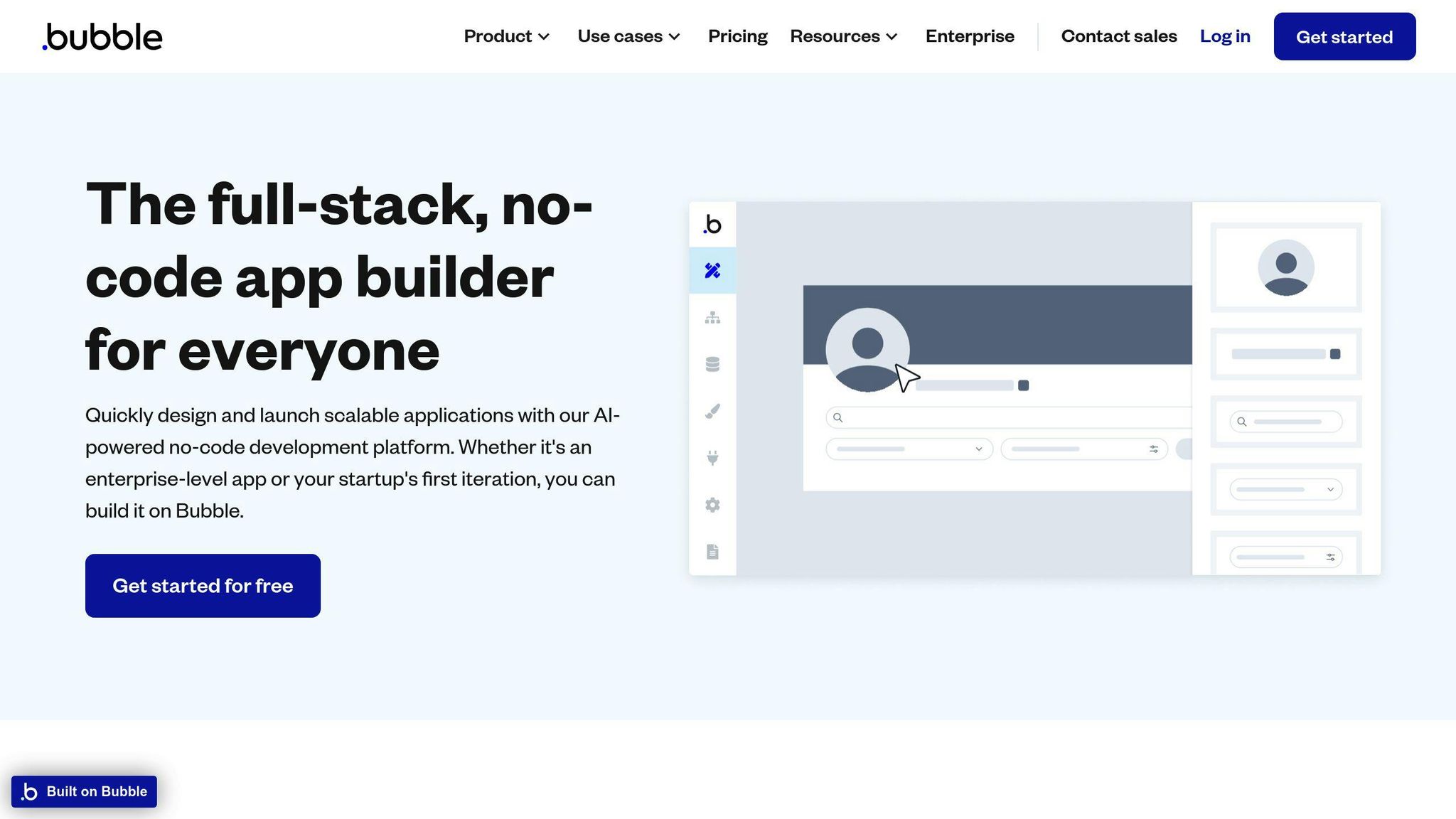
Bubble gives you a lot of freedom to build web and mobile apps without coding. Why it's good:
- Lets you create pretty much any app
- Good for making test versions of your app
- Works for both web and mobile
- Can add extra features with plugins
- Pay based on how much you use it
Pros: Very open-ended and powerful. Lots of extra features.
Cons: Can be tough to learn. Costs can add up for big apps.
Backendless
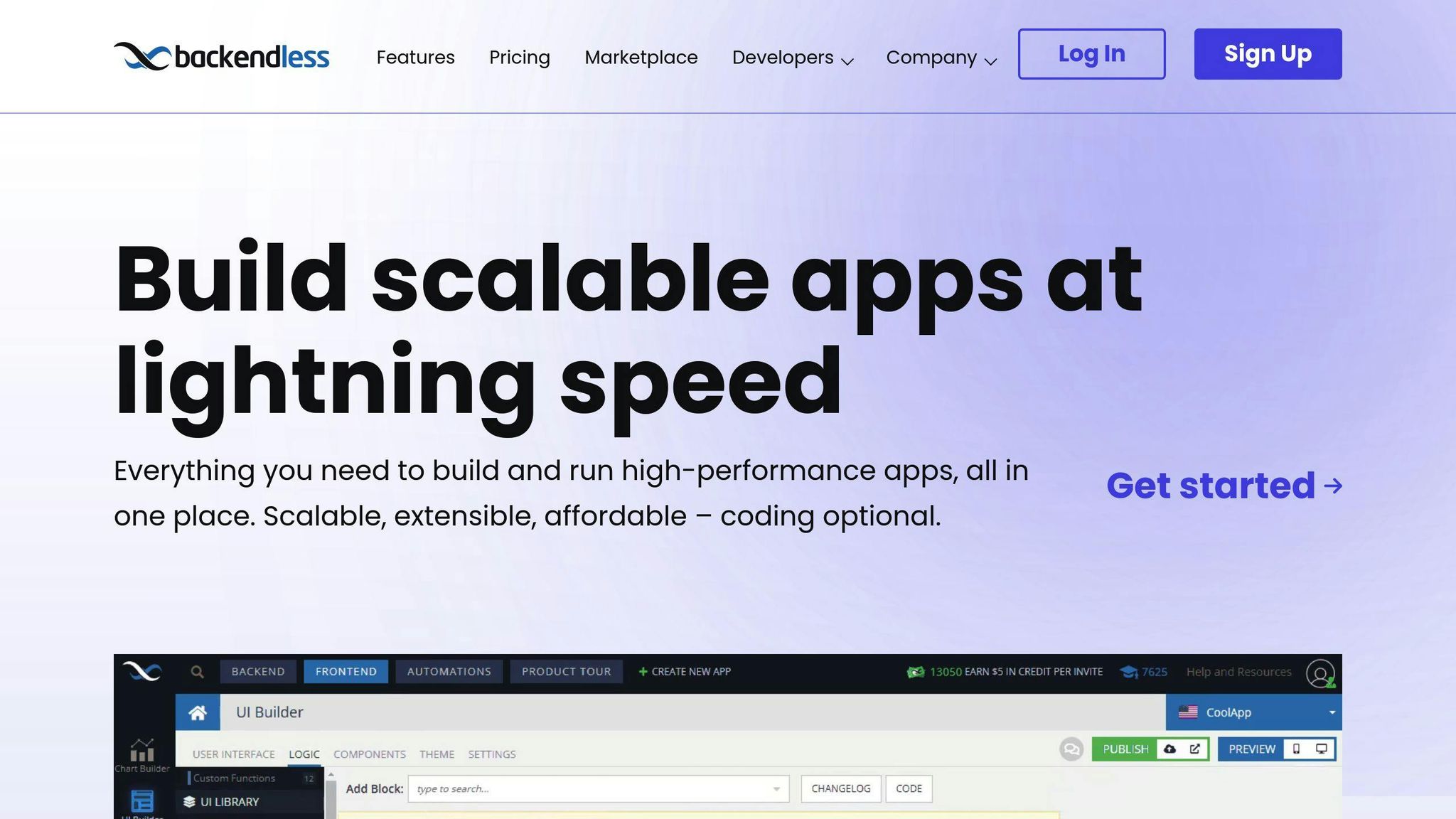
Backendless is all about giving you control over the app-building process, from the front end to the back end. It's packed with features:
- Visual app building
- Make your own APIs
- Comes with database, hosting, and security
- Lets you tweak the tech stuff
- Add-ons available
Pros: Lots of control and flexibility. Free version is generous.
Cons: Hard to learn. Might be too much for simple app projects.
FlutterFlow

FlutterFlow is for building apps that work on all devices using Flutter. Here's the scoop:
- Make apps for iPhone, Android, and web all at once
- Customize the look and feel
- Use modern web tech for fast apps
- Can add your own code for more complex features
- Open-source options available
Pros: Good for making apps for any device. Flexible design. Can grow with your needs.
Cons: Only makes Flutter apps. Has a learning curve.
eMOBIQ
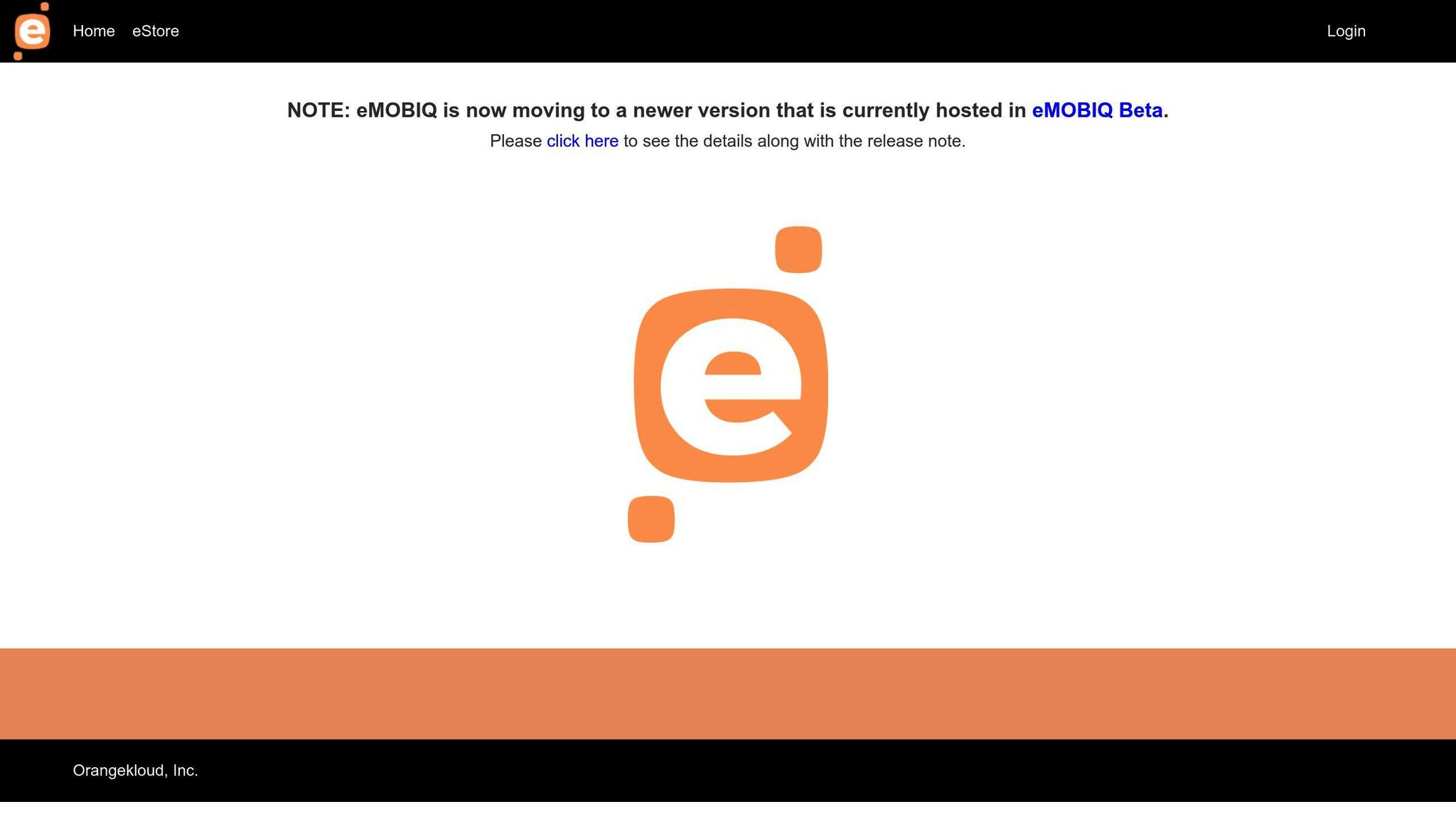
eMOBIQ is aimed at businesses needing to make apps that connect to their existing systems. What to know:
- Links to databases and business software
- Good for making work apps and processes
- Stores data for use offline
- Manages users and security
- Runs on the cloud
Pros: Strong at integrating with other systems. Good for offline use. Free tier available.
Cons: Interface feels clunky. Learning it takes time. Could look nicer.
Criteria for Choosing a React Native No Code App Builder
When you're picking a tool to build your React Native app without coding, think about what you really need. Here's a simple guide to help you choose:
Ease of Use
- How easy is it to start using it? Can someone without tech skills figure it out?
- Is dragging and dropping things around straightforward? Can you make changes without a fuss?
- Are there helpful guides, videos, or online communities to get you unstuck?
Flexibility & Customization
- Can you make the app look and work the way you want?
- Can it connect to other services or tools you use?
- If you need to, can you add your own coding touches?
Feature Set
- Does it have everything you need to make your app?
- Can it do fancy stuff like AI automation or handle lots of data?
- Are there enough options to build what you're imagining?
Publishing & Updates
- How do you get your app out there, and what's involved in updating it?
- Can you launch on both Apple and Android stores?
- How simple is it to send out app updates?
Security
- How does it keep your app and data safe?
- Can it handle sensitive information properly?
- What's in place to stop data from getting out or being attacked?
Scalability
- Will it keep up as more people use your app or as you need more space?
- Can it grow with your app without a lot of extra work?
- Is it good for big, complex apps or just simpler ones?
Cost
- Is the price within your budget?
- Are there any hidden fees or limits?
- How does the cost compare to making an app the traditional way?
Thinking about these points will help you find the right no code app builder for your project. Start with what's most important for your app, then check out the extra features.
sbb-itb-3a330bb
How to Get Started with a React Native No Code App Builder
Getting started with a no code React Native app builder is straightforward. Here are some steps to follow:
Plan Your App
Think about what you want your app to do. Sketch out your app screens on paper and how users will move from one to another. Make a list of any special things your app needs. This plan will help you explain your app better to the app builder.
Pick a Builder
Choose an app builder that matches what you need for your app and fits your budget. Try out a free trial if they offer one. Draftbit, Glide, and Bubble are all friendly for beginners.
Design the Interface
With the builder's drag-and-drop tools, add things like buttons, text fields, and images to your app. Most builders come with ready-to-use components. Arrange these elements in a way that makes sense for how you want users to interact with your app.
Connect Screens
Make your app's screens flow together by linking them. This tells the app how to move from one screen to another. Test this by clicking through to make sure it feels right.
Add Logic
Use the builder to make your app do things, like showing information from a database or sending alerts. You might also connect to other services or add AI automation for smarter features.
Try It Out
Preview your app on a phone to see it from a user's perspective. Adjust anything that doesn't look or work right.
Publish & Update
Once your app is how you want it, launch it on app stores. Most builders make it easy to update your app later.
Starting with something simple and building up from there is key. These no-code tools are very visual and user-friendly. Spend some time exploring all the features they offer to really make your app stand out.
Case Studies and Success Stories
Here are some real stories about people who used React Native no-code tools to build apps, and what they learned along the way.
Fitness App for Personal Trainers
John, a personal trainer, wanted to create an app to help with his clients and share workout plans. He chose Draftbit because it didn't require coding.
The App
- Shows videos of workout exercises
- Sends reminders for workout sessions
- Keeps track of client progress
What Worked Well
- He could quickly make a good-looking app using ready-made parts
- It was easy to update with new features
- The app was fast and worked well for users
Lessons Learned
- It took a bit of time to get used to the tool
- There were limits on making very specific designs
- He needed some coding for the more complex parts of the app
Verdict: Draftbit was a good choice for a basic app. John needed some help with coding for the more detailed features.
Restaurant Table Booking App
Mary wanted an app for her restaurant that would let customers book tables. She used Bubble to make it without hiring a developer.
The App
- Lists available tables and times
- Allows online table booking
- Alerts staff about new bookings
What Worked Well
- She could start with templates
- Connecting booking data to staff alerts was straightforward
- She could add special features easily
Lessons Learned
- Setting up the data correctly took a few tries
- She had to figure out how to prevent overbooking
- The app got slow when too many people used it at once
Verdict: Bubble was great for the basic needs of the app. Mary needed to tweak it to handle lots of users at the same time.
App for Coordinating Volunteers
A nonprofit group needed a simple app to manage their volunteers. They chose Glide because it was budget-friendly and didn't require coding skills.
The App
- Displays open volunteer opportunities
- Lets volunteers sign up for shifts
- Sends reminders for upcoming shifts
What Worked Well
- It was very user-friendly, with no learning curve
- They could quickly make a working app
- The cost was low
Lessons Learned
- The app couldn't do complicated tasks
- Customizing the app was hard
- It took a while to get help from technical support
Verdict: Glide was the right choice for a simple, cost-effective app. However, it wasn't flexible enough for more complex needs.
The Future of No Code Development in React Native
No code tools for building apps without needing to code are getting better and more people are using them. React Native is a popular way to make apps that work on both iPhones and Android phones. Let's talk about what might happen next with these tools and React Native.
Expanded Capabilities
No code tools will get better at making more complex apps. We'll see things like better animations, 3D effects, smart features using AI, and apps that can connect to smart devices. React Native is a good fit for adding these advanced features into no code tools.
Tighter Integration
React Native and no code tools will work together more smoothly. Some no code platforms might become the go-to choice for React Native, making it easier to connect everything right from the start. Making apps with React Native using these tools will feel more natural.
Cloud-Based IDEs
Making React Native apps will move to the web, with tools that work in your browser instead of needing to install software. This will make it easier for people to work together from anywhere. Features like seeing changes in real time and fixing problems on devices from far away will become possible.
AI Assistance
AI will help a lot with making React Native apps without coding. It will offer smart suggestions, help test apps, improve how well they work, and more. This will make it easier for everyone to make better apps quicker. React Native's setup lets these AI tools help out more effectively.
Specialized Tools
Alongside tools that do everything, we'll see special tools just for React Native. These will have everything set up just right for React Native, making it faster to start making an app. This means you can build apps quicker.
Business Empowerment
These tools will keep making it easier for non-coders to make their own apps. This is great for businesses because they can make apps without waiting for tech experts. React Native's ability to work on both iPhones and Android means they can reach more people.
Looking ahead, the future is exciting for making React Native apps without needing to code. We'll see better tools, help from AI, and more people able to make their own apps quickly.
Conclusion
React Native no code app builders let you create mobile apps without needing deep coding knowledge. You can simply drag and drop parts to build your app, making the whole process quicker and less expensive than the old way of doing things.
Here's what you need to know about these tools:
- They work for both iPhone and Android apps.
- You can put an app together quickly using pieces that are already made.
- You don't have to spend a lot of money hiring developers.
- They're pretty easy to figure out, even if you're not a tech expert.
- You can connect your app to other services and add smart features easily.
When picking a no code tool for React Native, think about:
- How easy it is to use.
- If you can change things to fit what you need.
- What kind of features it offers.
- How you can get your app out to your users.
- If it keeps your app and user information safe.
- If it can handle more users or data as your app grows.
Some of the best tools out there like Draftbit, AppMaster, and Bubble help you build apps by just moving things around on the screen. As these tools get better, they're making it easier for anyone to make an app.
By knowing what to look for and understanding the top options, you can find the right no code platform for your project. These tools are all about making app creation straightforward and fast for everyone.

